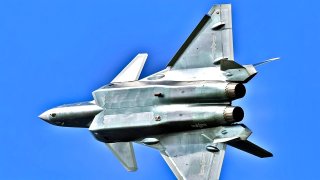How the Air Force Might Be Planning to Fight China's J-20 Stealth Fighter
Ultimately, China’s J-20 is arguably the most formidable counter to America’s own F-22 and F-35 fifth-generation fighters.
A full-scale replica of China’s fifth-generation J-20 fighter jet was reportedly unveiled at a U.S. Marine Corps base in North Carolina this summer.
According to Defence-blog, the mockup of the airframe was allegedly recorded and uploaded onto Twitter.
Marines were carrying out training exercises with the R80 SkyRaider Unmanned Aerial System near Marine Corps Outlying Field Atlantic alongside the J-20 replica in July, according to the Tweet.
While the intended use of the J-20 remains unknown, Marines may have been using the mock-up as part of training drills.
If a kinetic conflict with the People’s Republic of China does erupt in the upcoming years, American aviators and pilots will undoubtedly confront Beijing’s J-20 fighters in the air.
Introducing China’s Premiere Fighter Platform
For decades, America retained air supremacy over its adversaries. When it produced the world’s first-ever fifth-generation fighter F-22 Raptor, Beijing and Moscow were left behind in terms of sheer capability. However, both countries have worked hard to modernize their respective aerial arsenals and now possess their own fifth-generation fighters.
Today, Russia’s Su-57 and China’s J-20 are considered by some to be on par with their American counterparts.
The Chengdu J-20 “Mighty Dragon” was derived from the late 1990’s J-XX program. Around this time, Beijing’s push to modernize its Air Force was really hitting its stride. In the decades prior, the People’s Liberation Army relied heavily on reverse-engineered and imported Russian designs. Even in the early 2000s, Beijing was still producing reverse-engineered variants of Soviet and Russian airframes, including the MiG-19, Su-27, and Su-35. For this reason, the development of the J-20 is even more significant for the PRC, since it marks the first time the country produced a highly advanced fighter without relying on Western or Russian designs/parts.
Although the first J-20 prototype made its maiden flight in 2010, several enhancements were incorporated into the airframe over the next few years. By 2014, a third prototype equipped with a more advanced design was produced. In addition to a modified driverless supersonic inlet intake, this prototype also featured stealth coating and redesigned vertical stabilizers.
Over the next few years, Chinese state media reported that the J-20’s design had been finalized and ready to enter mass production.
J-20 Specs and Capabilities
By 2017, the J-20 was in active service with the PLA’s Air Force. Blended wings and fuselage, internal weapons bays, and radar-absorbent coating are some of the characteristics that make the J-20 a recognizable fifth-generation platform.
In terms of power, the Chinese platform can reportedly pack a punch. The airframe can carry six missiles, including four medium or long-range air-to-air missiles in its main bay and one smaller short-range missile in both its internal weapons bays. External fuel canisters can also be fitted on the platform.
As detailed by Air Force Technology, “It is designed to execute ground attack missions even in hostile environments. The aircraft can reach higher altitudes with its delta wings at supersonic speed to achieve strategic independence. The fifth-generation fighter can complement the air superiority variant currently in service and will be used to monitor the Taiwan Strait and the East China Sea.”
Another area that the J-20 is believed to excel in is its range. The Mighty Dragon can reportedly travel over 1,000 miles on internal fuel. In comparison, the American F-22 Raptor can only manage 600 miles.

However, this dichotomy may shift once the F-22s receive the stealth fuel tanks that Lockheed Martin is allegedly working on. The J-20’s domestically produced WS-15 engines are on paper more capable than their Pratt and Whitney F119 counterparts. However, these new engines have yet to be tested in battle and have suffered in previous testing stages.
Ultimately, China’s J-20 is arguably the most formidable counter to America’s own F-22 and F-35 fifth-generation fighters.
While the extent of the Mighty Dragon’s capabilities remains unknown, the potential threats these airframes can pose to U.S. fighters in war should not be dismissed.
Maya Carlin is an analyst with the Center for Security Policy and a former Anna Sobol Levy Fellow at IDC Herzliya in Israel. She has by-lines in many publications, including The National Interest, Jerusalem Post, and Times of Israel. You can follow her on Twitter: @MayaCarlin.
All images are Creative Commons.


